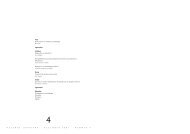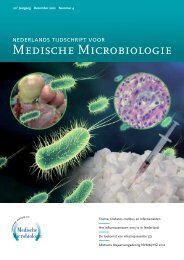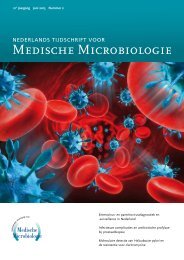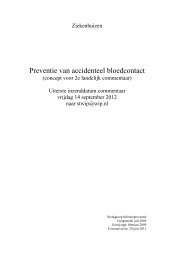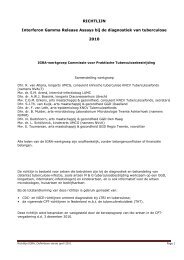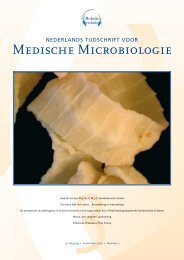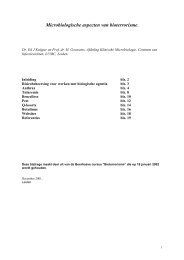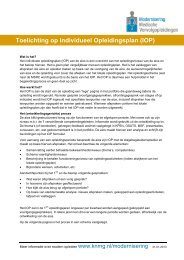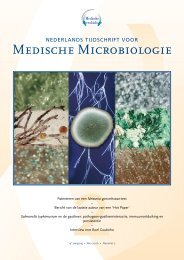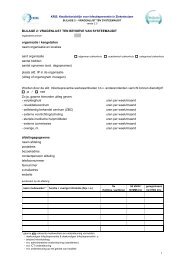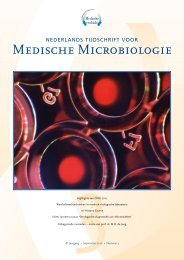S1 De voorjaarsbijeenkomst van de Nederlandse ... - NVMM
S1 De voorjaarsbijeenkomst van de Nederlandse ... - NVMM
S1 De voorjaarsbijeenkomst van de Nederlandse ... - NVMM
You also want an ePaper? Increase the reach of your titles
YUMPU automatically turns print PDFs into web optimized ePapers that Google loves.
collectively referred to as C. difficile associated disease<br />
(CDAD). The cell cytotoxicity (CT) assay is consi<strong>de</strong>red<br />
the gold standard for <strong>de</strong>tection of toxigenic C. difficile.<br />
However, this method is laborious and time-consuming<br />
(turn-around time: >48 hours). Rapid diagnosis of CDAD<br />
is important, since it may result in early treatment and help<br />
prevent nosocomial transmission. Therefore, a real-time<br />
PCR based assay was <strong>de</strong>veloped and validated. Also, this<br />
assay will be used as a screening tool for a gastroenteritis<br />
study (GEops Study). This study will commence in May<br />
2008 in 6 hospitals in the Netherlands. Its primary goal<br />
is to assess the inci<strong>de</strong>nce, etiology and course of patients<br />
hospitalised for gastroenteritis.<br />
Methods: An assay targeting the tcdA and tcdB genes<br />
was <strong>de</strong>veloped. Stools were processed with the easyMAG<br />
specific A stool protocol (bioMérieux). The phocine herpes<br />
virus-1 was used as internal control. The selectivity of<br />
the assay was validated with a panel of well characterised<br />
C. difficile strains and clinical isolates (n=50) and non-C<br />
difficile strains (n=43). The analytical sensitivity was<br />
assessed by dilution series (n=3), spiked in a homogenous<br />
faecal matrix. Also, the assay was compared with the CT<br />
assay in a clinical validation performed on stool samples<br />
(n=163) of patients suspected of CDAD.<br />
Results: The screening assay proved to be specific for C.<br />
difficile as no cross-reaction was observed. The assay was<br />
capable of <strong>de</strong>tecting approximately 1560 CFU/g of stool<br />
with a 100% hit rate. Sixteen PCR positive and 139 PCR<br />
negative samples were in complete concordance with the<br />
CT assay. The PCR was positive in 8 additional samples<br />
which remained negative in the CT assay. One of these<br />
8 samples could be confirmed as truly positive by CT in<br />
a consecutive sample of the same patient. In comparison<br />
with the gold standard (CT) PCR showed 100% sensitivity,<br />
95% specificity, 67% positive predictive value, and 100%<br />
negative predictive value. PCR inhibition was observed in<br />
less than 1% of all 163 screened stool samples.<br />
Conclusions:<br />
1. This in-house real-time PCR assay offers a rapid and<br />
sensitive method for the first screening for CDAD.<br />
2. The assay will be used as a rapid screening tool for the<br />
<strong>de</strong>tection of C. difficile in the GEops Study that will<br />
commence in May 2008.<br />
O061<br />
Characterization of Clostridium difficile ribotype 078 from<br />
human and animal origin<br />
D. Bakker<br />
<strong>De</strong>pt. KML, Lei<strong>de</strong>n University Medical Centre, Lei<strong>de</strong>n<br />
Background: A recent study <strong>de</strong>monstrates that Clostridium<br />
difficile PCR-ribotype 078 (Type 078) is the predominant<br />
ribotype in cattle. Type 078 seems to be an emerging<br />
Ned Tijdschr Med Microbiol 2008;16:Supplement<br />
S26<br />
type in human disease, with an increase from 5.6% of all<br />
submitted isolates to the national reference laboratory in<br />
2006 to 10% in 2007. To characterise human and animal<br />
type 078 isolates in more <strong>de</strong>tail, we applied ‘multi locus<br />
variable tan<strong>de</strong>m repeat analysis’ (MLVA) and investigated<br />
the isolates for the presence of resistance genes (ermB) and<br />
genes encoding enterotoxin A (tcdA), cytotoxin B (tcdB)<br />
and binary toxins (cdtA, cdtB). Additionally, we sequenced<br />
a part of the negative regulator (tcdC) of the pathogenesis<br />
locus and <strong>de</strong>termined the susceptibility pattern of 51 C.<br />
difficile both human (n=43) and pig (n=8) type 078 isolates.<br />
The isolates originated from human diarrhoeal patients<br />
(n=60) from the year 2005, 2006 and 2007 and from<br />
diarrhoeal pigs (n=10).<br />
Methods: The presence of the toxin and ermB genes<br />
was established by conventional PCR using previously<br />
<strong>de</strong>scribed primers. Sequencing of the tcdC gene was<br />
performed by cycle sequencing and analysis. Susceptibility<br />
to moxifloxacin, ciprofloxacin, clindamycin and erythromycin<br />
was investigated using E-test method using the<br />
most recent CLSI breakpoints (2007). MLVA was applied<br />
on 19 human and 10 pig isolates. Genetic relationships<br />
were <strong>de</strong>termined by clustering isolates according to MLVA<br />
type using the summed absolute distance as the coefficient<br />
for calculating the minimum-spanning tree.<br />
Results: All 51 strains tested positive for tcdA, tcdB, cdtA<br />
and cdtB. The ermB gene was present in 50% of pig and<br />
7% of human isolates (average percentage 14%). All 51<br />
characterised isolates contained two point mutations at<br />
location 183 bp and 184 bp and had a 39 bp <strong>de</strong>letion in<br />
the tcdC gene. Resistance for moxifloxacin, ciprofloxacin,<br />
clindamycin and erythromycin was found in 12, 88, 6<br />
and 75% of the isolates, respectively. MLVA revealed<br />
that, with the exception of one human isolate, all (97%)<br />
tested human and pig type 078 isolates were genetically<br />
related (single locus variants (SLV’s) with a summed<br />
tan<strong>de</strong>m repeat difference (STRD) ≤10). Two genetically<br />
highly related (clonal) clusters were found (SLV’s with a<br />
STRD ≤2), containing both human (n=7) and pig (n=6)<br />
isolates.<br />
Conclusions:<br />
3. Toxin profiles (tcdA, tcdB, cdtA and cdtB) of human and<br />
pig isolates were i<strong>de</strong>ntical;<br />
4. Most of the isolates (66%) highly resistant to<br />
clindamycin and erythromycin are ermB positive.<br />
5. The point mutation at location 184 bp introduces a<br />
stopcodon in the tcdC gene leading to a non-functional<br />
tcdC gene.<br />
6. In total, 97% of human and pig type 078 isolates were<br />
genetically related. Two genetically highly related<br />
(clonal) clusters containing both human and pig isolates<br />
suggesting zoonotic transmission.<br />
7. C. difficile type 078 isolates have the same virulence<br />
markers as the highly virulent C. difficile ribotype 027.



